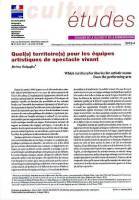Jérémy SINIGAGLIA
october 2013
12 p.
How do artistic teams from the performing arts deploy their creative and dissemination activities on their home territory? Through what strategies do they consolidate their local roots or do they promote mobility, within and beyond the regional territory?
From the use of administrative data and a qualitative survey conducted in Alsace and Lorraine, the study distinguishes two delivery networks which structure regional cultural space: a primary network which includes large private rooms and State-approved rooms, and a secondary network where we will find institutions supported by the State and local authorities, and private rooms on a smaller commercial scale. Furthermore, a qualified parallel network also offers dissemination opportunities for artists, for satisfactory employment and payment conditions: school network and occasional employers in the private sector, for musical entertainment, for example.
Predominantly residing in regional cities which also focus on cultural facilities and employers, the artistic teams from the performing arts deploy differentiated logics which strengthen the attachment or mobility, experienced or chosen as the case may be. Whilst the local roots of the artistic teams are necessary for them to be awarded funding by the local authorities and may also be a sign of positive attachment, mobility beyond their home territory allows them to access the primary delivery network, diversify their employers and broaden awareness.


